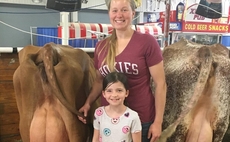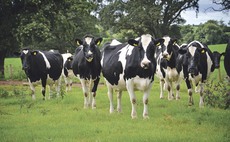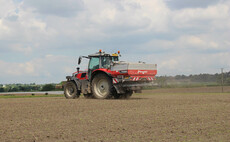
A front-mounted rake has improved operational efficiency for one Yorkshire grower, who now rows-up and bales silage as a one-pass operation. Geoff Ashcroft reports.
For many operators, front linkage does little more than carry ballast. But for Pete Houseman of North House Farm near Tadcaster, Yorkshire, front linkage holds the key to greater operational efficiency.
This is because when he goes round baling, Mr Houseman puts a front-mounted Abimac twin rotor rake on the tractor's nose, streamlining his operation.
"Labour and diesel both have an impact on my business so anything that helps me to work more efficiently, as a one-man operation, is worth a closer look," explains Mr Houseman. "If you do the same as you have always done, you will continue to get the same as you have always had."
He says that up until last year, a neighbour had been providing the raking operation, working ahead of Mr Houseman.
"The short, catchy weather windows just seemed to compromise how our silage is made, and so I looked at a cost-effective means of taking more control of silage quality," he says.
Having invested in a plain mower, the missing link was the rake. But opting for a traditional twin rotor model for the rear linkage would have meant doing each job separately.
"I thought it would be a great idea to combine jobs, by raking and baling simultaneously," he says. "So I organised a demonstration with Abimac UK, and I was so impressed that the rake never left the farm."
The 73 hectare family farm is predominantly grass, with a small area of cereals in the rotation, providing grain and straw for the Housemans 80 cow suckler herd. Each season, the farm produces a few thousand bales comprising mostly silage and hay.
"Using a front-mounted rake saves a pass, and that saves me time in the field," he says. "And if the weather suddenly changes, swaths will not get wet."
He says that the most obvious downside of the unit is its length. The rake adds another 3m to the nose of his Fendt 724 tractor, though it is equipped with two sideways facing, wireless cameras to help with pulling out of field gateways and road junctions.
"It does not take long to get used to the length and also when manoeuvring around the yard," he adds. "The rake sits on the lower link arms and runs on a front castor wheel, so it does steer fairly easily but you do need generous corners. I can use the top link and go for a complete lift if needed."
In-field though, he says the outfit really comes into its own, once the challenge of headlands has been overcome.
"You just have to think about straight lines, so it is handy having auto-steering guidance on my tractor rather than follow a field curve," he says. "I do not have to concentrate on steering, so there is time to watch what is going on and make fine adjustments if necessary.
"Though, I am still working out the best way to tackle headlands. The first run is the trickiest and this season I am going to try with the inner rotor lifted, so I can pull the outer swath into the field, to create more space in corners."
When entering a headland corner, Mr Houseman lifts the baler pickup and steers the rake to create the swath. This usually results in the baler cutting the corner, but with the pickup raised, this does not present a problem. "Corner swaths are easily collected afterwards, when you turn out of the first few field runs," he says. "I just keep the rotors in the air and bale those few bits as I loop around."
With an average field size of around 35 acres, he says the unit is easy to manage on long, straight runs. "As I stop the baler to apply net, I also lift the two rotors to prevent it making a ball under the tractor," he says. "Then I lower the rake and carry on baling."
He says that forward speeds are typically 10-14kph depending on the crop. "There is no need to travel slower with the baler, because I have a rake in front of me," he says. "With grass spread out behind the mower - or tedded - I do make the swaths to suit the baler, so the raking width is tweaked according to crop density. This also avoids weaving down the rows to fill the baler's pickup.
"It is also easy enough to manually adjust the raking width, as bolts are used to secure the telescopic sections," he adds. "It is a 10 minute job."
Mr Houseman says the widest settings could be used in straw. "As it is currently set, I can comfortably pull together two 17 foot straw swaths, and I am sure it would just about collect two 20 foot swaths," he says.
In very small fields though, he prefers to rake and bale separately, simply to overcome the physical limitations of manoeuvrability of such a combination in a small field. "I now have the ability to choose which method is best suited to a particular field or crop type," he says.
The Abimac rake is powered by an integral hydraulic motor, requiring just a feed and a free-flow return to run the single hydraulic motor that then powers the rotors through conventional pto shafts. Raking height is manually adjusted, though rotor lift is achieved on a single-acting spool which simultaneously lifts both rotors - lowering them is a job for gravity. However, a locking tap allows the oil feed to one lift ram to be isolated, creating single rotor lift.
Mr Houseman has found that rotor speed can be easily tweaked through the Fendt Vario terminal, which means the unit is not bound by a fixed pto speed that is required for the baler.
"That is one of the attractions of this system - total flexibility," he says. "And matching the speed of the rake to my forward speed means I can create a decent sized, lump-free swath. If the rotors are running too fast, they will also create more debris on drier days, which could cause premature blocking of the tractor's front grilles.
"So far, cooling has not been an issue, because I clean the radiators after every day's baling," says Mr Houseman. "Combining raking and baling is proving to be a really efficient process for me."
Having recently invested in a Krone Comprima baler, bought to replace a 40,000-bale JD592 model, he says that the ultimate rake, bale and wrap combination currently remains a dream, but adding more front mounted kit is on his agenda.
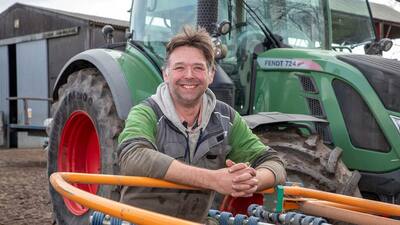
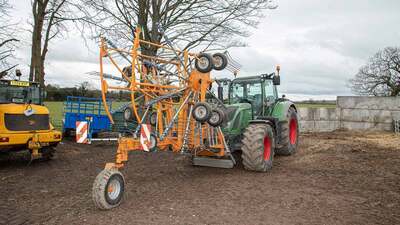
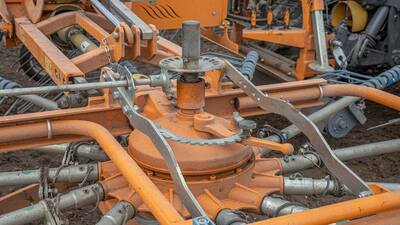
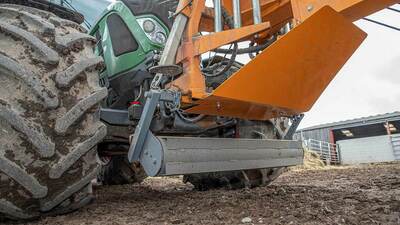
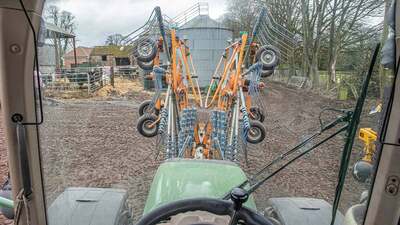
Rake details
- Model: Abimac Avantime 7810-13
- Working width: 7-7.8m
- Rotors: two, 3.4m diameter
- Tine arms: 13
- Drive: Hydrostatic
- Weight: 1,750kg
- Length: 3m
Verdict
Mr Houseman says that choosing a front-mounted rake lets him make the most of weather conditions in pursuit of higher quality forage, while working with the limitations of a limited labour supply. "It is a clever idea that makes my life easier.
"I still have to go back into every field to wrap the bales, but I have cut one pass out with this system," he adds. "I would also like to add a front-mounted mower to increase mowing output and efficiency."






















